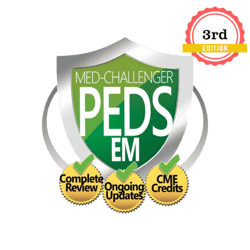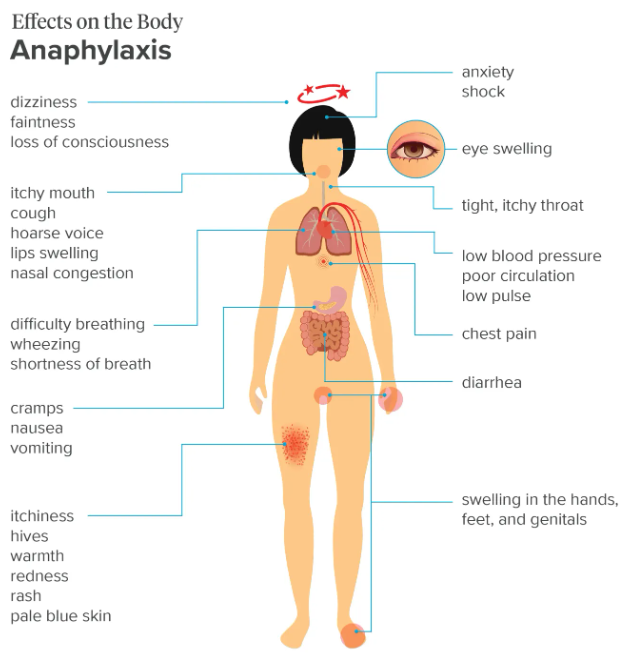Most Missed Question in Pediatric EM – Acute Mastoiditis Antibiotics
Why are People Missing This Pediatric EM Exam Prep Question?
Key takeaway: In uncomplicated pediatric mastoiditis, start IV beta-lactam therapy (ampicillin/sulbactam or ceftriaxone); add vancomycin only for MRSA risk, and reserve antipseudomonal coverage for chronic ear disease or tympanostomy-tube otorrhea.
Question – Empiric therapy choice
A 20 mo boy presents with fever and ear pain. The patient began with fever 5 days ago and was seen by his pediatrician and diagnosed with acute otitis media (AOM). He was started on amoxicillin and has been taking it as prescribed. Since that time his fever has continued, and he has complained of increasing pain. He has no prior history of AOM and has been otherwise healthy. His exam reveals a non-toxic appearing child with tenderness posterior to his ear along with the finding below.
 Photograph courtesy of Jillian Savage, DO
Photograph courtesy of Jillian Savage, DO
What is the appropriate intravenous antibiotic choice for this patient?
Answers:
A. Ampicillin/sulbactamB. Cefepime and vancomycin
C. Clindamycin
D. Vancomycin
The keyed answer (vancomycin) was incorrect. Validated correct answer: Ampicillin/sulbactam.
Why: The clinical picture and image show acute mastoiditis (pinna protrusion, postauricular erythema/tenderness/swelling) complicating AOM in a previously healthy toddler without recurrent AOM or chronic ear disease. Current guidance favors empiric IV beta-lactam therapy (ampicillin/sulbactam or ceftriaxone) to cover S. pneumoniae, S. pyogenes, H. influenzae, and MSSA. Vancomycin is added only when MRSA risk exists; antipseudomonal agents (e.g., cefepime) are reserved for chronic suppurative disease, tympanostomy-tube otorrhea, or recurrent AOM. Sources: AAP Red Book 2021–2024; CHOP Clinical Pathway 2024; UCSF IDMP 2021–2024; RCH Melbourne CPG 2022.
Many examinees over-escalate to vancomycin monotherapy or vancomycin plus antipseudomonal therapy. However, vancomycin alone lacks Gram-negative coverage (e.g., non-typeable H. influenzae) and is not first-line in uncomplicated cases. Broad antipseudomonal combinations are reserved for children with recurrent/chronic ear disease or tubes with otorrhea.
Boards expect you to map the empiric regimen to the clinical context: uncomplicated mastoiditis → beta-lactam (ampicillin/sulbactam or ceftriaxone) ± vancomycin only for MRSA risk; chronic/recurrent disease or tubes/otorrhea → add antipseudomonal coverage.
Why This Pediatric Emergency Medicine Question Is Often Missed
-
Pattern-recognition bias: mastoiditis prompts knee-jerk “vancomycin” even when MRSA or chronic ear disease isn’t present.
-
Failure to recall that vancomycin lacks coverage for common Gram-negative AOM pathogens.
-
Overgeneralization of antipseudomonal therapy to all mastoiditis rather than limiting to chronic/recurrent disease or tympanostomy-tube otorrhea.
What the Distractors Indicate
| Option | What It Tests / Implies | Why It’s Wrong Here |
| Ampicillin/sulbactam | First-line beta-lactam coverage for uncomplicated mastoiditis | This is actually correct per current guidance (AAP Red Book; CHOP; UCSF). |
|---|---|---|
| Cefepime and vancomycin | Regimen for chronic ear disease/tubes or pseudomonal risk | Overly broad; no history of recurrent AOM, tubes, or otorrhea to suggest Pseudomonas. |
| Clindamycin | MRSA/MSSA and anaerobe coverage | Poor S. pneumoniae coverage and no Gram-negative coverage; inadequate empiric choice. |
| Vancomycin | MRSA-focused therapy | Lacks Gram-negative coverage (e.g., H. influenzae); not first-line in uncomplicated mastoiditis. |
High-Yield Pearl
Uncomplicated pediatric mastoiditis: start IV ampicillin/sulbactam or ceftriaxone; add vancomycin only with MRSA risk; add antipseudomonal coverage only for chronic/recurrent disease or tubes with otorrhea.
Core Learning Objectives
1. Select appropriate empiric IV antibiotics for pediatric acute mastoiditis based on clinical context (uncomplicated vs chronic/recurrent/tubes).2. Differentiate when to add MRSA and/or antipseudomonal coverage according to risk factors.
The Exam “Test Trick” at Play
The stem omits MRSA and pseudomonal risk factors; the image drives a reflex toward “big guns.” Resist escalation unless the history includes MRSA risk or chronic ear disease/tube-related otorrhea.
Additional Peds EM Practice Questions and Remediation for Acute Mastoiditis
Pediatric Emergency Medicine Practice Question 1 - Uncomplicated mastoiditis
A 3-year-old with 3 days of worsening postauricular swelling after AOM; no tubes, no MRSA history, immunizations up to date, nontoxic.
A. Vancomycin
B. Ampicillin/sulbactam
C. Cefepime + vancomycin
D. Clindamycin
E. Linezolid
Answer and Remediation
A — Review: Lacks Gram-negative coverage; not first-line without MRSA risk.
B — Correct response!: Empiric beta-lactam coverage for common pathogens in uncomplicated mastoiditis (AAP Red Book; CHOP).
C — Review: Overly broad; reserve for chronic ear disease/tubes/otorrhea.
D — Review: Insufficient coverage of S. pneumoniae and Gram-negatives.
E — Review: Not first-line; MRSA-specific without Gram-negative coverage.
Pediatric Emergency Medicine Practice Question 2 - Tubes with otorrhea
A 2-year-old with tympanostomy tubes and purulent otorrhea develops mastoid tenderness, pinna protrusion, and fever.
A. Cefepime + vancomycin
B. Ampicillin/sulbactam
C. Vancomycin
D. Ceftriaxone
Answer and Remediation
A — Correct response!: Tubes/otorrhea raise pseudomonal risk; add MRSA coverage if indicated (CHOP, UCSF).
B — Review: Lacks antipseudomonal activity needed here.
C — Review: No Gram-negative coverage; inadequate.
D — Review: Good for uncomplicated disease but not for pseudomonal risk.
Pediatric Emergency Medicine Practice Question 3 - MRSA risk only
A 4-year-old with prior MRSA skin abscess now has uncomplicated mastoiditis; no tubes or otorrhea.
A. Ceftriaxone alone
B. Ampicillin/sulbactam + vancomycin
C. Cefepime alone
D. Clindamycin
Answer and Remediation
A — Review: Lacks MRSA coverage in a high-risk child.
B — Correct response!: Add vancomycin for MRSA risk to standard beta-lactam therapy (AAP Red Book).
C — Review: Unnecessary antipseudomonal spectrum without indication.
D — Review: Inadequate pneumococcal/Gram-negative coverage.
Pediatric Emergency Medicine Practice Question 4 - Chronic suppurative OM
A 6-year-old with months of otorrhea and conductive hearing loss presents with mastoiditis; afebrile but toxic-appearing.
A. Ampicillin/sulbactam
B. Piperacillin–tazobactam + vancomycin
C. Vancomycin alone
D. Ceftriaxone alone
Answer and Remediation
A — Review: Insufficient for chronic suppurative disease with pseudomonal risk.
B — Correct response!: Broad antipseudomonal plus MRSA coverage for chronic ear disease (UCSF, RCH).
C — Review: Lacks Gram-negative coverage.
D — Review: No pseudomonal coverage.
Pediatric Emergency Medicine Practice Question 5 - De-escalation
A 2-year-old started on ampicillin/sulbactam for uncomplicated mastoiditis improves; middle ear culture grows pan-susceptible S. pneumoniae.
A. Continue IV ampicillin/sulbactam indefinitely
B. Narrow to high-dose IV ampicillin or ceftriaxone and transition to oral when stable
C. Add vancomycin
D. Switch to cefepime
Answer and Remediation
A — Review: Overly broad and prolonged IV not needed once improving with organism identified.
B — Correct response!: De-escalate per culture and transition to oral when clinically stable (stewardship).
C — Review: No MRSA indication.
D — Review: Unnecessary antipseudomonal coverage.
Mini Case Discussion Prompt
Compare empiric therapy choices for mastoiditis in: (a) unimmunized toddler without tubes; (b) child with tympanostomy tubes and active otorrhea; and (c) child with prior MRSA infection but no chronic ear disease. Discuss how each scenario modifies the need for MRSA and/or antipseudomonal coverage and the role of early ENT consultation.
Mini-FAQ
- Q: Do all children with mastoiditis need vancomycin?
A: No. Add vancomycin only when MRSA risk exists; beta-lactam monotherapy is first-line in uncomplicated cases.
- Q: When is antipseudomonal coverage indicated?
A: In chronic suppurative otitis media, recurrent AOM, or tympanostomy-tube otorrhea—situations associated with Pseudomonas.
- Q: What if imaging shows a subperiosteal abscess?
A: Continue appropriate empiric antibiotics and obtain urgent ENT consultation; many require surgical drainage in addition to antibiotics.
- Q: Which beta-lactam is preferred initially?
A: Ampicillin/sulbactam or ceftriaxone are both acceptable per AAP Red Book and pediatric institutional pathways; choose based on local susceptibility, allergy, and severity.
Find this and other Pediatric Emergency Medicine exam prep questions in Med-Challenger Pediatric Emergency Medicine 3rd Edition Exam Review with CME
Try for free and save. Ace your exams and meet your CME/MOC requirements.
No matter your program, no matter the size, Med-Challenger for Groups and Institutions can better prepare your program or group, fulfill industry requirements, and increase test scores.







